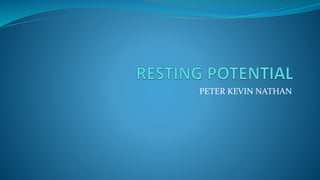Resting Membrane potential
•Télécharger en tant que PPTX, PDF•
40 j'aime•13,242 vues
Resting membrane potential, equilibrium potential GHK equation
Signaler
Partager
Signaler
Partager

Recommandé
Contenu connexe
Tendances
Tendances (20)
Synaptic integration, Types of synapses, EPSP and IPSP

Synaptic integration, Types of synapses, EPSP and IPSP
Receptor by Pandian M, Tutor, Dept of Physiology, DYPMCKOP, MH. This PPT for ...

Receptor by Pandian M, Tutor, Dept of Physiology, DYPMCKOP, MH. This PPT for ...
Similaire à Resting Membrane potential
Similaire à Resting Membrane potential (20)
2. BIOPHYSICS – Membrane Potentials and Action Potential.pptx

2. BIOPHYSICS – Membrane Potentials and Action Potential.pptx
Dernier
https://app.box.com/s/7hlvjxjalkrik7fb082xx3jk7xd7liz3TỔNG ÔN TẬP THI VÀO LỚP 10 MÔN TIẾNG ANH NĂM HỌC 2023 - 2024 CÓ ĐÁP ÁN (NGỮ Â...

TỔNG ÔN TẬP THI VÀO LỚP 10 MÔN TIẾNG ANH NĂM HỌC 2023 - 2024 CÓ ĐÁP ÁN (NGỮ Â...Nguyen Thanh Tu Collection
Dernier (20)
Asian American Pacific Islander Month DDSD 2024.pptx

Asian American Pacific Islander Month DDSD 2024.pptx
TỔNG ÔN TẬP THI VÀO LỚP 10 MÔN TIẾNG ANH NĂM HỌC 2023 - 2024 CÓ ĐÁP ÁN (NGỮ Â...

TỔNG ÔN TẬP THI VÀO LỚP 10 MÔN TIẾNG ANH NĂM HỌC 2023 - 2024 CÓ ĐÁP ÁN (NGỮ Â...
ICT role in 21st century education and it's challenges.

ICT role in 21st century education and it's challenges.
Role Of Transgenic Animal In Target Validation-1.pptx

Role Of Transgenic Animal In Target Validation-1.pptx
This PowerPoint helps students to consider the concept of infinity.

This PowerPoint helps students to consider the concept of infinity.
Measures of Dispersion and Variability: Range, QD, AD and SD

Measures of Dispersion and Variability: Range, QD, AD and SD
ICT Role in 21st Century Education & its Challenges.pptx

ICT Role in 21st Century Education & its Challenges.pptx
Ecological Succession. ( ECOSYSTEM, B. Pharmacy, 1st Year, Sem-II, Environmen...

Ecological Succession. ( ECOSYSTEM, B. Pharmacy, 1st Year, Sem-II, Environmen...
Presentation by Andreas Schleicher Tackling the School Absenteeism Crisis 30 ...

Presentation by Andreas Schleicher Tackling the School Absenteeism Crisis 30 ...
Web & Social Media Analytics Previous Year Question Paper.pdf

Web & Social Media Analytics Previous Year Question Paper.pdf
On National Teacher Day, meet the 2024-25 Kenan Fellows

On National Teacher Day, meet the 2024-25 Kenan Fellows
Mixin Classes in Odoo 17 How to Extend Models Using Mixin Classes

Mixin Classes in Odoo 17 How to Extend Models Using Mixin Classes
Resting Membrane potential
- 2. Resting potential electrical potential difference between the inside of the cell and the surrounding extracellular fluid membrane potential All cells need the MP to carry out various biological processes (nerves and muscles), because changes in their membrane potentials are used to code and transmit information. When a nerve or muscle cell is at ‘rest’ it’s membrane potential is called resting membrane potential.
- 3. Resting potential values in different types of cells Cell types Resting potential Skeletal muscle cells −95 mV Smooth muscle cells –60 mV Astroglia –80 to –90 mV Neurons –60 to –70 mV Erythrocytes –9 mV Photoreceptor cells –40 mV
- 4. Resting potential The electrical pot. of the i.c space is always negative compared to the e.c space because there is an excess of negative charge inside of the cell. Equilibrium potential the net transmembrane flux of an ion (k+) is zero. Nernst eq: Eq. potential for k+ is around -89mV. Na+ is around +60mV
- 5. Thermodynamic equilibrium (K+) One k+ comes into the cell, at the same time one k+ goes out of the cell. Thus no net flux of K+ and the MP does not change. Energy is not expended K+ Electrochemical equilibrium No net transport of charge and no net flux of chemical gradient. K+ cell
- 6. Factors determining the resting potential Goldman-Hodgkin-Katz voltage equation/diffusion potential, GHK equation: Represents all ion species, most significant contribution. concentrations of ions, permeability, conductance of each ion species. Not a thermodynamic equilibrium. When the permeability of a given ion increases dramatically, the RMP gets closer to the Eq. pot. of the given ion.
- 7. Factors determining the resting potential Pump Potential 3Na+ are being pumped out and 2K+ pumped in against their concentration gradients. Requires energy. Donnan Potential large impermeable negatively charged intracellular molecules (proteins) attracting positively charged ions (e. g.: Na+ and K+) and repelling negative ones (e. g.: Cl−)
- 8. THANK YOU
